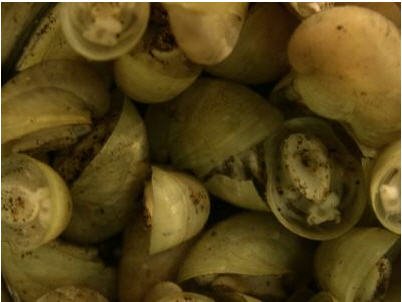
Experts urge deep-sea explorers to take care not to spread deep-sea creatures around the world during exploration of the remote ocean floor.
Scientists using the famous Alvin sub say the vehicle picked up limpets from a depth of almost 3,000m and inadvertently transferred them alive to another location more than 600 km away.
It is surprising because the animals had to cope with huge pressure changes as Alvin conducted its dives.
The researchers report the event in the journal Conservation Biology.
Spreading organisms artificially beyond their range in this way could have damaging effects on marine ecosystems, they warn, either by introducing competitors or even disease.
The team urges other deep-sea explorers to exercise extreme caution, and to assume hardy stowaways could be hanging on to their vehicles.
The curious case of the limpets is described by Janet Voight, from the Field Museum of Natural History in Chicago.
Janet Voight and colleagues were studying lifeforms living around hydrothermal vents off the north-west coast of the United States.
Such vents are among the key study targets of modern oceanographic science – places where amazing collections of animals and other organisms thrive in mineral-rich, hot waters that gush up from volcanic cracks in the seabed.
Indeed, it was Alvin that first discovered these ecosystems in 1977.
On one dive to a depth of 2.7 km on the Gorda Ridge, the team gathered various specimens with the submersible’s sampling tools.
The group then climbed back up the water column and moved Alvin, via its support ship, to a new dive location 600 km to the north, on the Juan De Fuca Ridge, to take yet more specimens.

When the scientists examined their haul back in the lab, they found examples of a limpet (Lepetodrilus gordensis) thought to live only on the Gorda Ridge existing also on the Juan De Fuca Ridge. The team thought it had discovered an entirely new population.
But doubts started to creep in when the researchers realized conditions at the second site could not have met the limpets’ nutritional requirements.
Chemical analysis then confirmed the two populations were in fact one – Alvin, despite being cleaned en route to the second dive, had carried stowaways in its sampling gear.
“It remains a mystery, but we suspect we didn’t fully clean the suction sampler,” said Dr. Janet Voight.
“Perhaps they were in a little crack somewhere. The hose on the suction sampler looks much like the hose on your vacuum cleaner, and perhaps they were hiding in the corrugations. We were late coming up from the dive and it was a bit dark – maybe they just weren’t seen.
“Lepetodrilus are incredibly tough, but there are others animals also from the deep sea that seem to do well when brought up to sea-level pressure – at least for a few days.”
Invasive species are one of the biggest problems in conservation today; introducing something new to an ecosystem can have devastating consequences.
So, for the team to discover it was responsible for the contamination is a matter of some embarrassment. But Dr. Janet Voight says the experience is a wake-up call to everyone working in the deep ocean.
“Hydrothermal vents are the most extreme, specialized habitats you can get – they spew out acidic, metal-rich fluids. And we could be messing with them without even knowing about it,” Dr. Janet Voight said.
“We were a biology cruise and so we should have been the most sensitive to this, but there are geology-focused cruises out there who might not even be aware of this potential.
“By publishing this – although it’s painful to admit errors – we want to make the point that this is something that needs to be taken seriously.”
While I admire the work of those who venture deep into the sea and share their explorations, I find it just as important to not disturb what’s living down there. They should have been more careful.